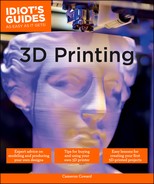2 The History and Future of 3D Printing
Hull’s and 3D Systems’ Contributions
The Development of Other 3D Printing Processes
Refinement, Availability, and Your Wallet
3 Manufacturing with 3D Printers and CNC Mills
The Simple Principle Behind 3D Printing
Slicing and Creating Layers for Your Model
Pros and Cons of 3D Printers vs. CNC Mills
Using the Right Tool for the Job
Part 2: All About the Hardware
Ways Cartesian 3D Printers Are Constructed
Cartesian Layout Considerations
The Importance of Frame Construction
Rigidity and How It Affects Quality and Reliability
Components for Smooth Linear Motion
Weight-Bearing Components for Converting Motion
Attachment and Connection Components
For Filaments with Different Properties
Heated Build Chambers and Enclosures
Arduinos and Proprietary Control Boards
Changing or Upgrading Control Boards
What Does It Mean to Be Open Source?
Part 3: Setting Up and Printing
11 Software Setup and Printer Control
Performing Functions Manually with G-Code
12 Leveling the Bed and Adjusting the Z Height
Why Does Your Bed Need to Be Leveled?
Setting the Z Height Manually or Automatically
Knowing the “Correct” Z Height
Configuring Your Slicing Software
Preparing for and Running a Print
14 Troubleshooting Your Prints
Cracking of Part Due to Cooling
Discoloration of Filament Due to Heat
Preheat the Extruder and Heated Bed
Load the .STL File and Resize the Model, If Necessary
Preheat the Extruder and Heated Bed, and Load the Filament
Modify the Slicer Settings to Make the Model a Cup
Preheat the Extruder and Heated Bed, and Load the Filament
Modify the Slicer Settings for Supports
Project 4: Storage Box with Drawers
Open Your Host Software and Load the Storage Body .STL File
Load the Drawer .STL File and Slice It
Artistic 3D Modeling vs. CAD Software
An Overview of Common CAD Program Commands
The Importance of Units and Scale
16 Modeling Techniques and Best Practices
17 Practical Reverse Engineering
Why You Should Learn Basic Reverse Engineering
Finding the Right Measurement Tools
Digital Calipers: A Necessary Tool
3D Scanners: Not All They’re Cracked Up to Be
Project 5: Monogrammed Coaster
Open Your CAD Program and Create a New Part
Export the .STL File and Print
Project 6: Custom Storage Drawer
Open Your CAD Program and Create a New Part
Extrude the Body of the Drawer
Export the .STL File and Print
Create a New Part and Revolve the Body
Create the Second Part and Revolve the Body
Export the .STL Files and Print
Project 8: Reverse Engineering a Useful Part
Create a New Part and Extrude the Body
Export the .STL File and Print
Part 5: Advanced Usage and Techniques
18 Printing with Other Materials
